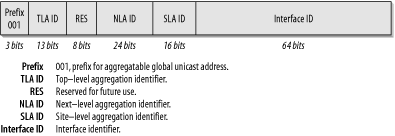Aggregatable Global Unicast Address
Aggregatable
global unicast addresses are
identified by the prefix 001, as shown earlier, in
Table 3-2. The initial address specification
defined provider-based
addresses; the name has been changed to
aggregatable global unicast address. The name
change reflects the addition of an ISP-independent means of
aggregation called exchange-based
aggregation
.
The prefix is followed by five components, as shown in Figure 3-3.

Figure 3-3. Format of the aggregatable global unicast address
The
format prefix 001
is assigned to the aggregatable global unicast address range. The
top-level aggregation
identifier
(TLA) contains the highest level of routing information about
the address. Its size of 13 bits limits the number of top-level
routes to 8192. In the earlier specification, the TLA was the
provider-based identifier. It was assigned to the
American Registry
for Internet Numbers (ARIN) in North America,
Réseau
IP Européens (RIPE) Network Coordination Center in Europe,
and Asia Pacific Network Information Center
(APNIC). With this change in the specification, the commercial touch
of the TLA has been removed and the focus is now on routing
optimization; the TLA does not need to be a provider. At the core of
the Internet, the routing tables need just one route entry per TLA,
so the 13-bit TLA is large enough.
Providers and exchange points use the next-level ...
Get IPv6 Essentials now with the O’Reilly learning platform.
O’Reilly members experience books, live events, courses curated by job role, and more from O’Reilly and nearly 200 top publishers.

